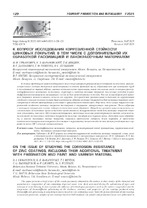К вопросу исследования коррозионной стойкости цинковых покрытий, в том числе с дополнительной их обработкой пассивацией и лакокрасочным материалом

Authors
Date
2025Publisher
Another Title
On the issue of studying the corrosion resistance of zinc coatings, including their additional treatment with passivation and paint and varnish material
Bibliographic entry
К вопросу исследования коррозионной стойкости цинковых покрытий, в том числе с дополнительной их обработкой пассивацией и лакокрасочным материалом = On the issue of studying the corrosion resistance of zinc coatings, including their additional treatment with passivation and paint and varnish material / Н. И. Урбанович, К. Э. Барановский, Т. И. Бендик [и др.] // Литье и металлургия. – 2025. – № 3. – С. 120-128.
Abstract
В статье представлен краткий обзор ранее полученных авторами результатов исследований химического, гранулометрического состава дисперсного цинксодержащего отхода (цинковой пыли), образующегося при цинковании труб и последующей их паровой обдувке, влияния технологических параметров, таких как состав смеси, температура термодиффузионного цинкования, на толщину, структуру и свойства цинковых покрытий, полученных методом термодиффузионного цинкования в насыщающих смесях на базе цинксодержащего отхода. Так как основной функцией цинкового покрытия является защита металла от коррозии, для проведения сравнительных испытаний на коррозионную стойкость в камере соляного тумана были изготовлены образцы цинковых покрытий на базе цинкового порошка и цинксодержащего отхода производства в установке с вращающимся контейнером. Известно, что с целью повышения коррозионной стойкости цинковые покрытия пассивируют и покрывают лакокрасочным материалом. Часть образцов с цинковыми покрытиями также подвергали дополнительной обработке. Проведение сравнительных испытаний в соляном тумане (в настоящее время испытания продолжаются) на коррозионную стойкость цинковых покрытий позволили установить, что после 300 ч испытаний покрытия, полученные на основе цинксодержащего отхода, незначительно уступают по защитным свойствам покрытиям на основе стандартного порошка цинка. Дополнительная обработка, а именно пассивация данных покрытий, позволила практически подавить белую коррозию. А применение комплексного лакокрасочного покрытия (пассивация + окрашивание) позволяет обеспечить полную устойчивость к коррозии не менее 300 ч в камере солевого тумана.
Abstract in another language
This paper presents a brief review of the results previously obtained by the authors in their studies of the chemical and granulometric composition of zinc‑containing dispersed waste (zinc dust) generated during the galvanizing of pipes and subsequent steam blowing. It also examines the influence of technological parameters such as the mixture composition and the temperature of thermodiffusion galvanizing on the thickness, structure, and properties of zinc coatings produced using thermodiffusion galvanizing in saturating mixtures based on zinc‑containing waste. Since the primary function of zinc coatings is corrosion protection, samples of zinc coatings based on both standard zinc powder and production waste were fabricated ina rotating container unit for comparative corrosion resistance testing in a salt spray chamber. It is well known that to enhance corrosion resistance, zinc coatings are commonly passivated and coated with paint materials. Some of the zinc‑coated samples were also subjected to additional treatments. The comparative salt spray chamber testing (ongoing at the time of writing) revealed that after 300 hours of exposure, the coatings produced from zinc‑containing waste only slightly underperformed in terms of protective properties compared to those made with standard zinc powder. Additional treatments, specifically passivation, nearly eliminated white rust formation. Furthermore, the use of a combined paint coating system (passivation + painting) ensured complete corrosion resistance for no less than 300 hours in the salt spray chamber.
View/
Collections
- № 3[16]
